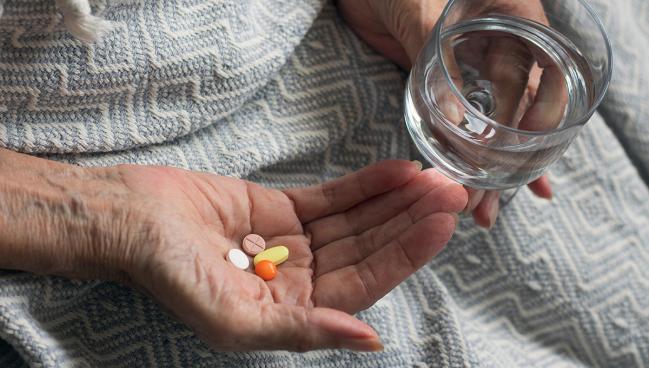Very Elderly Benefit From High-Intensity Lipid-Lowering After Acute MI
Even at a mean age of 85 years, there is still time to accrue mortality benefits from potent LDL-lowering therapies.

Older patients who have been discharged from the hospital after myocardial infarction are at a significantly lower risk of all-cause mortality if treated with high-intensity lipid-lowering therapy, according to a new analysis from the FAST-MI registry.
In this observational study of 2,258 patients aged 80 years and older, high-intensity lipid-lowering therapy, which could include a potent statin or combination therapy, was associated with a 22% lower risk of death at 5 years when compared with no such treatment. However, conventional-intensity statin use was not associated with any reduction in the 5-year risk of all-cause mortality.
“Pending the results of specific randomized controlled trials in the very elderly, our data suggest that the prescription of high-intensity lipid-lowering therapy to elderly people sustaining an acute myocardial infarction should not be restrained on the sole basis of their older age,” Antoine Fayol, MD (Assistance Publique-Hôpitaux de Paris/Hôpital Européen Georges-Pompidou, France), and colleagues write online this week in Circulation: Cardiovascular Quality and Outcomes.
Senior investigator Nicolas Danchin, MD, PhD (Assistance Publique-Hôpitaux de Paris/Hôpital Européen Georges-Pompidou), told TCTMD that he hadn’t expected to see a mortality reduction in this elderly patient group.
“My personal bias was that I felt that using high-intensity lipid-lowering agents in the very elderly was probably useless because they might have died of anything else other than coronary artery disease,” he said. “The mean median age was 85 in the [FAST-MI] cohorts, so they were fairly old, and I thought that conventional doses of statins might be enough, but this is not what we showed.”
Michael Nanna, MD (Yale University School of Medicine, New Haven, CT), who has studied the treatment and care of older adults with cardiovascular disease, said that potentially beneficial treatments are often withheld from patients solely on the basis of chronological age.
“Certainly, in the case of statins, there’s no reason to believe those agents wouldn’t be effective in older adults, and this study supports that,” Nanna told TCTMD. “We’ve shown in the PALM registry, and other studies have shown the same, that the apprehension around safety with statins in older adults is not necessarily correct. Older patients actually seem to tolerate statins as well or better than younger patients. I think the reticence on the part of clinicians is probably unfounded.”
Nanna said there’s often a misperception that once patients get to a certain age, they no longer benefit from preventative therapy because they don’t have enough time. However, one of the strongest predictors of life expectancy is how long a person has already survived, he said, noting that if people have lived to 80 or 85 years old, they can expect to live for several years more.
“When you compare that to the randomized trial for statins, for example, and you look at the follow-up time for those studies, it's probably around the same time,” he said. “If you expect that you should see benefits within 4 or 5 years, then you should be prescribing those medicines, because the time to accrue those benefits in terms of life expectancy is there.”
Defining ‘Elderly’
While statins are a well-established way to reduce the risk of cardiovascular morbidity and mortality after acute MI, the pivotal randomized, controlled trials didn’t include many older patients, mostly because they had other comorbidities and conditions. For those that did include elderly patients, “older” was typically defined as 65 years and up. The PROSPER trial with pravastatin focused solely on statin use in elderly patients, for example, but the mean age of study participants was 75 years. Similarly, the Cholesterol Treatment Trialists Collaboration also showed that statins benefit both the young and old in secondary prevention, but that analysis also defined elderly as 75 years and older.
“It’s very difficult to know whether the conclusions of the main trials apply to very old patients,” said Danchin. “And by very old, I mean everyone over 80 years of age.”
The FAST-MI registry focuses on a 1-month snapshot of the characteristics, management, and outcomes of all STEMI and NSTEMI patients admitted to a cardiology department in France within 48 hours of symptom onset. Based on surveys from 2005, 2010, and 2015, a total of 2,258 patients were 80 years and older: among them,415 patients were discharged without lipid-lowering therapy, 866 discharged with a conventional-intensity statin, and 977 discharged on a high-intensity statin (atorvastatin ≥ 40 mg, rosuvastatin ≥ 10 mg, or any statin dose used in combination with ezetimibe).
Those treated with high-intensity lipid-lowering therapy were more likely to be younger, be admitted for STEMI, and have fewer comorbidities, such as diabetes, heart failure, and atrial fibrillation, than those discharged with conventional doses or no therapy at all. Women were also less likely to be treated with high-intensity statins.
Survival rates at 5 years were 58%, 47.5%, and 36% for those discharged on high-intensity lipid-lowering therapy, conventional-intensity lipid-lowering therapy, and not given any LDL-lowering therapy at all. In a multivariable regression model, high-intensity statin therapy was associated with a lower risk of all-cause mortality at 5 years (HR 0.78; 95% CI 0.66-0.92) versus no therapy, while conventional doses were not (HR 0.93; 95% CI 0.80-1.09). Comparatively, high-intensity treatment was associated with a lower risk of death at 5 years when compared with lower-intensity statins (HR 0.85; 95% CI 0.74-0.97).
These results were consistent in the propensity-matched analysis and across various subgroups. There was no significant interaction according to age (80 to 85 years vs those 85 years and older), sex, use of PCI, or the prior statin use.
Danchin said there has been a “huge change” in the prescription of high-intensity statins since 2005. “Although the population itself is not very different from one survey to the other, the management clearly differed,” he said. As for whether randomized, controlled trials with high-intensity statins (or combination therapy) will be conducted in the very elderly, Danchin isn’t optimistic.
“My feeling is that there's not much likelihood of that,” he said. “The observational data, provided they are well done, are worthwhile for taking into consideration. So I think that if the patients seem to have a reasonable life expectancy, it's really worthwhile treating them with high doses.”
Real-world Older Patients
For Nanna, these results are consistent with the benefits seen in the general secondary-prevention population, including those that have involved patients in their seventies. However, one important component of the new observational study is that it captures a more representative population of the truly elderly, he said.
“Even if older patients were included in some of the trials, oftentimes they are not fully representative of the broader population, who may have prevalent geriatric syndromes and comorbidities,” said Nanna. “Using observational cohort studies, you might get a more representative population of older adults.”
The FAST-MI analysis, he added, will hopefully reassure physicians and motivate them to prescribe high-intensity statins to older patients, confident that there’s a benefit.
“The population is aging,” said Nanna. “Older adults make up the majority of the patients that I take care of and any publication that brings the care of older people to the forefront, and demonstrates that the cardiovascular therapies that we're delivering maintains efficacy even into advanced ages, that’s important.”
Michael O’Riordan is the Managing Editor for TCTMD. He completed his undergraduate degrees at Queen’s University in Kingston, ON, and…
Read Full BioSources
Fayol A, Schiele F, Ferrières J, et al. Association of use and dose of lipid-lowering therapy post-acute myocardial infarction with 5-year survival in older adults. Circ Cardiovasc Qual Outcomes. 2024;Epub ahead of print.
Disclosures
- Fayol reports no relevant conflicts of interest.
- Danchin reports received personal fees and nonfinancial support from Amgen, AstraZeneca, Bayer, Bristol-Myers Squibb, and Sanofi; and personal fees from Boehringer Ingelheim, Intercept, Merck, Sharp & Dohme, Novo Nordisk, Pfizer, Servier, Union Chimique Belge Pharmaceuticals, and Vifor.





Comments